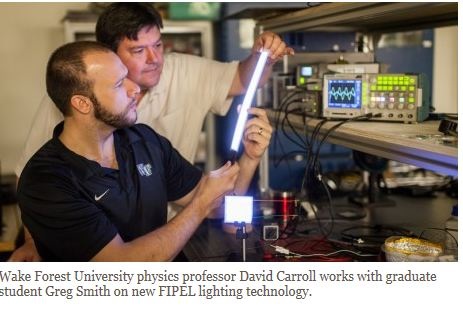They are omnipresent in the workplace, and can be annoying. I am not referring to loud-mouthed co-workers, but rather those buzzing and not necessarily pleasantly illuminating overhead fluorescent light bulbs we all toil under. News from Wake Forest University (WFU), Winston-Salem, North Carolina, shows we may be on our way toward ditching those old bulbs for new ones, based on what is being called field-induced polymer electroluminescent (FIPEL) technology. The result of tests done so far is a light source that is a flicker-free, shatterproof alternative for large-scale lighting that according to provides a “soft, white light – not the yellowish glint from fluorescents or bluish tinge from LEDs.”
In announcing the release of the breakthrough WFU’s David Carroll, professor of physics and director of the Center for Nanotechnology and Molecular Materials noted that, “People often complain that fluorescent lights bother their eyes, and the hum from the fluorescent tubes irritates anyone sitting at a desk underneath them. The new lights we have created can cure both of those problems and more.”
A nano-engineered polymer matrix converts electric charges into light. The research supporting the technology is described in a study appearing online in advance of publication in the peer-reviewed journal Organic Electronics.
Graduate student Greg Smith has worked on this project for about two years, first developing a system to test the efficiency of the device.

Image via Wake Forest University
What hath Wake Wrought?
As described by the team working on the project, the device is made of three layers of moldable white-emitting polymer blended with a small amount of nanomaterials that glow when stimulated to create bright and perfectly white light similar to the sunlight human eyes prefer. However, white light is not the only capability. It is explained that devices can be made in any color and any shape – from 2×4-foot sheets to replace office lighting to a bulb with Edison sockets to fit household lamps and light fixtures.
What about power consumption you ask? Here there is also good news. The new lighting solution is at least twice as efficient as compact fluorescent (CFL) bulbs and on par with LEDs. WFU researchers are quick to point out that bulbs made of the material have the added advantage of being shatter-proof and therefore will not contaminate a home or office like CFLs and do not emit a bluish light like LED-based products. And, FIPELs also are long-lasting; Carroll has one that has worked for about a decade.
The professor said, “If you wanted blue lights, discos would still be popular. You want lights that have a spectral content that is appealing to us inside of a building…You want a light that won’t shatter and create a hazmat situation while your children are around.”
Carroll’s group is the first to make a large-scale FIPEL that can replace current office lighting and is based on natural white light. Beyond office and home lighting, he sees potential uses for large display lighting as well.
Wake Forest is working with a company to manufacture the technology and plans to have it ready for consumers in the next year. In fact, Carroll and Wake Forest are no strangers to making important innovations in lighting and energy. Back in 2010, under Carroll’s guidance, WFU received a European patent for new fiber solar cells that are able to capture twice as much energy as flat cells. The technology was then licensed to FiberCell Inc. to develop a way to manufacture the cells which are viewed as a way to greatly enhance energy production, particularly in poorer developing economies.
Nanotechnology has been heralded for several years as “the next big thing.” It is a case where really little things can pay big dividends. I don’t know about you, but I am looking forward to the soft touch when it comes to the lighting, not just in TMC’s offices, but also at home.
Edited by
Rachel Ramsey